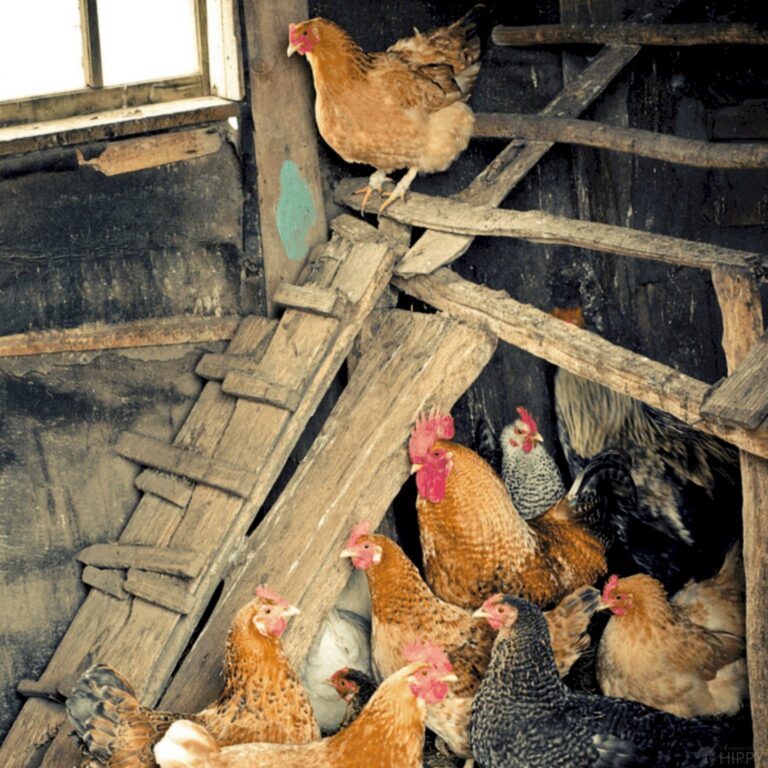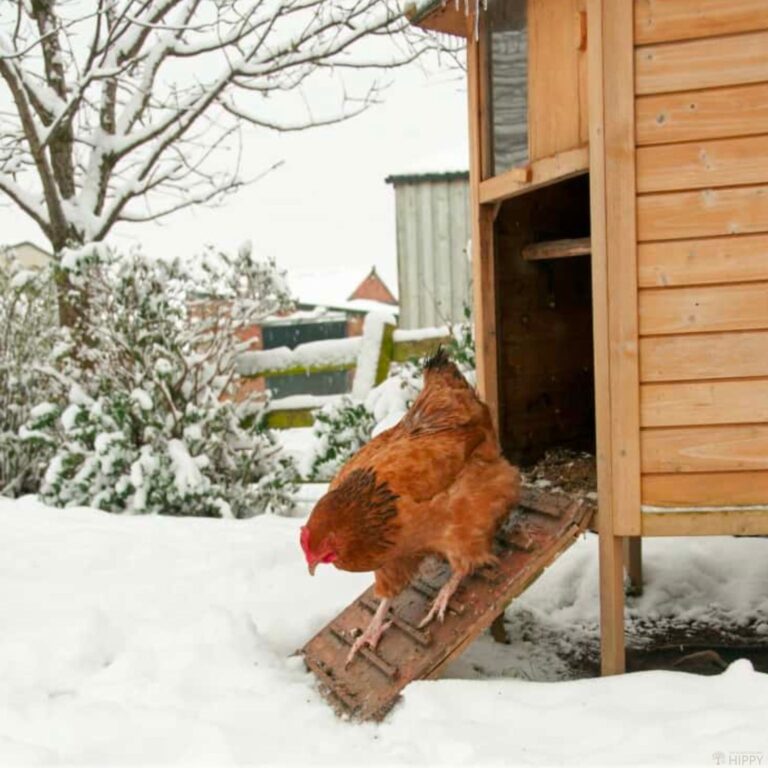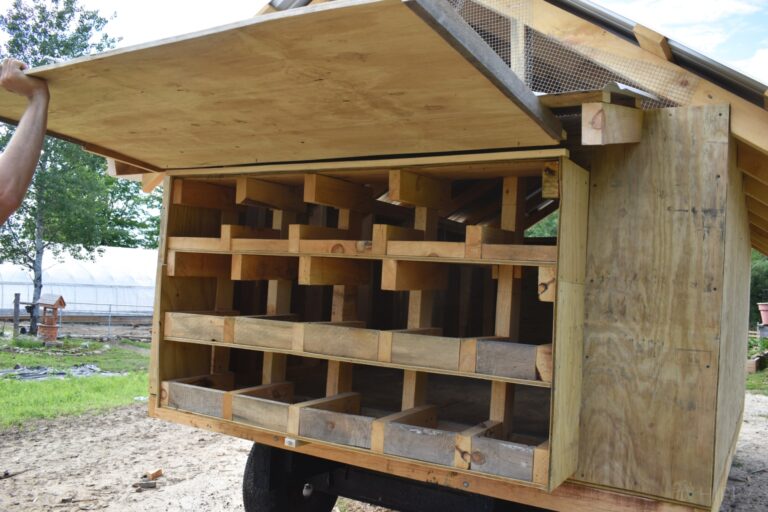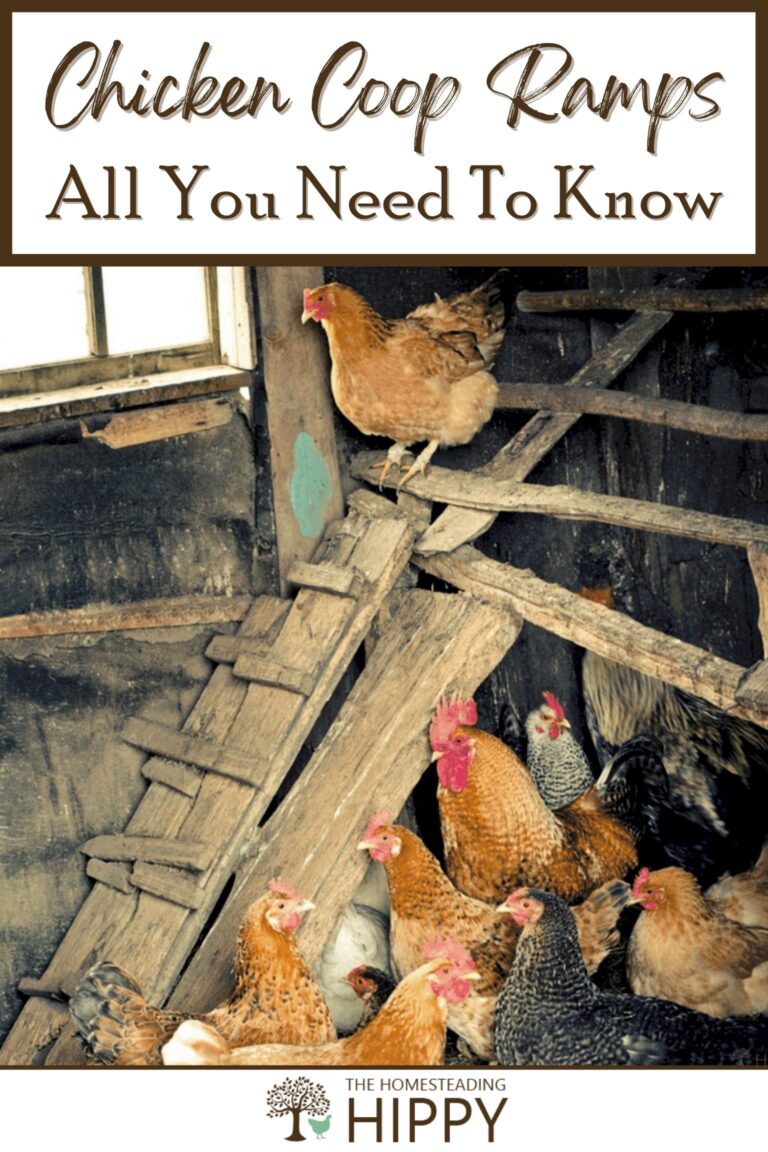If there is one feature of a chicken coop that is truly iconic, it is probably the cleated ramp that leads out of the door down to the ground.

It seems like whatever the style of the coop, and wherever it is located, it will always have a ramp.
Why is that? Are these ramps just a traditional and long-accepted accessory of a chicken coop?
Not hardly! Though they are certainly charming in an aesthetic sense, chicken coops actually serve a very important practical purpose by helping chickens get in and out of the coop safely without injury or strain.
There are especially needed for any coop that is elevated or any coop with an elevated door.
Making your chickens go without a ramp into the coop when they actually need one is a recipe for injuries, stress, and disharmony in the flock.
Luckily, selecting, installing, and even building your own ramp is a simple process, and usually a snap to get your birds to use it. This guide will tell you everything you need to know about chicken coop ramps.

Table of Contents
Do Chickens Really Need A Ramp to Get in Their Coop?
Not always, but ramps are almost always a good idea.
When there is a significant height difference between the coop door and ground level it will definitely help and will reduce injuries and mishaps.
Jumping up and down from a pop door can put too much strain on chickens if they have to jump up or down frequently, especially in the case of heavier breeds or ones that don’t fly well for whatever reason. This is even truer for older birds!
Making life easier for your chickens will keep them happy, safe, and content. Happy chickens are more productive and healthier, which makes your job and life a lot easier.
What is the Difference between a Ramp and a Ladder?
A ramp is basically just a gently sloping platform that connects two levels of different heights, such as the coop floor/door and the ground, allowing chickens to make their way up or down without having to jump strenuously.
A ladder is typically more steeply pitched, offering rungs between two spars for support when making the same ascent or descent.
Both are viable, but a ramp is safer and easier to use when properly designed and installed.
However, a ladder might be needed in case you would otherwise install a nearly vertical ramp. More on that later.
When Should You Install a Chicken Coop Ramp?
As I said, not every coop or flock needs a ramp, but most do. You should definitely install a ramp if any of the following apply to your chicken situation:
- You have a coop door that is more than 8 inches off the ground.
- You have a coop door that is just big enough to admit chickens.
- You have heavy breeds in your flock, e.g. Brahma, Jersey Giant, etc.
- You have elderly birds in your flock that have difficulty negotiating height changes.
- You have birds that don’t fly well, e.g. injuries, clipped wings, naturally flightless, etc.
If any of the above applies to your chickens or your coop, you positively need to install a ramp in order to make their lives easier and safer. Fortunately, doing so is a snap!
What are the Best Materials for a Chicken Coop Ramp?
Like everything these days, you can get chicken coop ramps made out of just about anything.
But not all materials are created equal and even fewer are truly suitable for a chicken coop ramp. The following are good bets for a reliable, safe ramp:
Pressure-treated Wood: A traditional and affordable option, but will require regular upkeep (sealing/staining). Risk of splinters when degraded or cheaply assembled.
Plywood: Cheaper than treated lumber but may not last as long in harsher climates. A high risk of slivers and splinters requires attention to maintenance.
Plastic: Inexpensive and very low maintenance. Easy to clean, but can be slippery for chickens especially in wet weather.
Alternate Choices
The following types of ramp material are options, but both have significant drawbacks. They might still be the right answer for specific coop setups.
Metal: More expensive and often heavy, but will last a very long time with minimal maintenance. Can be slippery in wet weather and must be kept out of direct sun to avoid burns. Typically very hard on chickens’ feet, especially when textured.
Rubber: Or over-molded rubber. Good traction, but can get hot in the sun. Very difficult to clean depending on type.
Which Material is Best for You?
If in doubt, go with wood or plywood. They are reliable, durable, and easy to customize.
Properly finished, wood is also easy to clean provides a better surface for traction without getting too hot in the sun or hurting your birds’ feet.
If you’re in an area with seriously harsh weather conditions or want a super low-maintenance ramp, plastic might still be the right choice for you but they are dang slippery.
Accidents might be funny but can seriously hurt your chickens! Whichever material you decide on, just make sure that it’s securely attached and does not interfere with your coop door.
And don’t forget to slope it at an appropriate angle for ease-of-use! More on that in the next section.
How Steep Can You Make a Chicken Coop Ramp?
A ramp is a benefit for your chickens only if it makes getting into and out of the coop easier.
A ramp that is too steep will do the opposite! If chickens have to scrabble or flap their way up the ramp, it increases the chances of accidents or falls, and will increase the likelihood of splinters from a wood ramp.
Even minor splinters can turn into major injuries, and will greatly increase the odds your chickens will get an infection or bumblefoot.
The ideal slope is a really shallow one, like 10-15 degrees. This will give your chickens ease of access and not require excessive effort to climb.
However, to make this work means you need either a really low coop or a really long ramp. Both are usually no-gos for most keepers.
Instead, a compromise is needed with the coop ramp set at 20-30 degrees.
This requires a little effort from chickens to climb it or descent it, but it is still a lot easier and safer than jumping up and down through the door while reducing splinters and falls.
Now, a steeper ramp may be okay, but if you are setting at greater than 30 degrees your ramp should have cleats on it.
In fact, you can make a good case for them on all ramps! Cleats are horizontal raised strips on the ramp that give chickens extra purchase, typically made of the same material the ramp is.
The steeper the ramp the more cleats you’ll need, as they should be closer together.
How Steep is Too Steep?
Chickens might appear to be pretty able climbers since they can hop and flap their way up inclines, trees and fences, but it is indeed possible to make a ramp too steep for chickens to effectively and safely use.
Generally, anything steeper than 35 degrees is starting to push it, and 45 degrees is out of the question, way too steep, even if your birds will use it with cleats.
How Wide Should Your Ramp Be?
Not too wide, not too narrow, 8-12″ is more than adequate, and err on the side of wider for bigger birds or steeper ramps. A ramp that is too narrow will make chickens using it accident-prone!
Summary: Characteristics of a Good Ramp
So, let’s tie it all together. A good chicken ramp will be:
- Constructed from Wood or Plastic
- Reasonable Slope: 10-30 degrees
- Have cleats, and definitely if steeper than 30 degrees
- Be 8-12″ wide for regular ramps
- Securely attached to the coop
- Not interfere with the coop door
Easy enough! But there is still more to consider.
Consider a Dogleg for a Steep Ramp or Confined Spaces
One of the major issues that plagues chicken keepers who need to install a ramp in close quarters or on a tall coop is dealing with steepness, specifically as a consequence of not having enough room for a really long ramp.
As we discussed above, a steep ramp is not great for chickens and can be dangerous, if they use it at all and don’t just decide to jump for it!
If you need to install a ramp with a favorable pitch but the coop is inside a run or other limited footprint, you might try a dogleg ramp.
A dogleg is a configuration for a ramp where the incline stops in an intermediate point, then continues in a different direction at the same angle. A switchback, if you will.
This may reduce the total incline and can make it easier for chickens to traverse when compared with a straight ramp steeply inclined over its entire length.
Think of a dogleg ramp as one with an elbow or turn with a little, flat platform, sort of like a bent staircase landing, that can allow you to make two sections of a ramp at a better angle than simply dropping one right down to the ground out of the door.
These require more effort to make and install and are almost always a DIY affair, but they can make the best possible use of limited space. If, of course, you can get your chickens to use them! More on that in a moment.
Can You Make Your Own DIY Coop Ramp?
Absolutely, and many owners do whether or not they build the coop themselves.
Ramps are dead simple and easy to fashion from whatever lumber you have around and the only tricky part, generally, is attaching them to the coop without getting in the way of the door.
For any DIY-savvy homesteader, they should be a cinch.
DIY’ing your ramp also ensures that it is made to the specific requirements of your coop and flock, and also gives you that wonderful sense of accomplishment that comes with building your own stuff. Plus, it’s a great way to save money on chicken-keeping costs!
Don’t forget to add cleats to your homemade ramp!
Be Sure to Finish Your DIY Ramp for Safety and Durability
Last thing on the DIY ramp. You can use raw wood for the purpose, but you’ll get the best results from your ramp if you take the time to finish it, one way or the other.
Sealer, paint, or other coatings will provide the ramp with greater resistance to weather and the abrasion it will endure from nails, beaks, and feet.
This is not just a matter of appearance: a properly finished ramp will last longer and is less likely to send a splinter or sliver into the foot of one of your poor birds, so it’s worth the effort and the added cost.
Getting Chickens to Use a Ramp
It’s one thing to build a ramp and quite another to get your flock to use it!
The good news is that most chickens are smart enough to know a good thing when they see it, and will happily and instinctively use a ramp when one is provided, assuming it is in fact easier.
Now, some chickens are either set in their ways and will continue to jump in and out of the coop door, ramp be damned, or else your flock might not get the picture, especially in the case of a dogleg or very long ramp.
How do you get the recalcitrant members of your flock to take advantage of the ramp you have so thoughtfully provided?
The best way is patience and positive reinforcement. Make sure that the chickens have access to small tidbits of treats or snacks in the coop and on the ramp leading up to it.
As they ascend to get another bite, that’ll show them what the ramp is for and entice them to use it. They can learn!
Over time, as more members of your flock learn through example, many others will soon follow suit.
Chickens are creatures of habit but also social, and chickens that have close bonds will typically imitate behaviors, including how they enter and exit the coop!
If you have a particularly obstinate chicken that just won’t get it, you might have success physically “walking” the bird up the ramp while holding it, and then doing the reverse after letting it out again. Don’t count on it, though!
How Should You Clean the Coop Ramp?
You can clean the coop ramp with the same soaps, chemicals, and additives that you use for the interior of the coop itself, so long as they are safe and approved for chickens.
This includes dusting it or washing it occasionally with the usual round of anti-parasite treatments you are used to, be it DE (diatomaceous earth) or something else.
Keep in mind the material of the ramp matters in this regard, and you should always double-check the label of any commercial product to ensure it is safe and functional for the material.
And do make it a point to keep the ramp clean. While it will rarely get as filthy as the interior of a coop or the ground of the run, debris can accumulate on the ramp over time and create infection risks for your chickens.
Make sure to remove any droppings and other debris when you see it, and wash it well when you clean out the rest of the coop.

What about Nesting Boxes? Do Chickens Need a Ramp to Them?
Maybe. A ramp to the nesting box helps in the same way as a ramp to a coop, but if you have multiple nesting boxes close together it is not practical or elegant to put a ramp to each.
In this case, a single ramp that can lead to all the boxes, giving hens a boost, should suffice.
Alternately, make sure that the nesting boxes are at an adequate height that your hens can access and let them jump.

Tom has built and remodeled homes, generated his own electricity, grown his own food and more, all in quest of remaining as independent of society as possible. Now he shares his experiences and hard-earned lessons with readers around the country.
Find out more about the team here.

I have had chickens now for 12 years. When I built my coop I installed a ladder because I thought that the rungs of the ladder would be like their rests inside the coop and easier for their feet to grab onto. Never thought of a ramp. A nice thing about a ladder….no clean up.